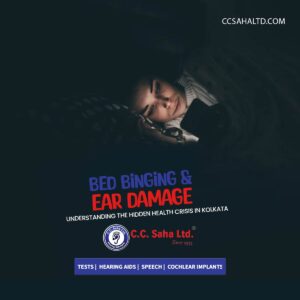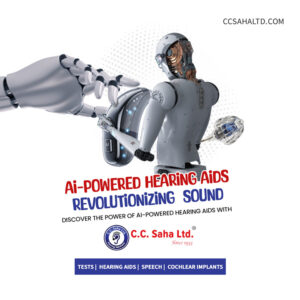
New Hearing Aids in Kolkata: When Is It Time for an Upgrade?
Wondering when to upgrade your hearing aids? Discover the signs, new tech, and expert care for new hearing aids in Kolkata with CC Saha Ltd.
In India, millions of people are impacted by hearing loss, a challenge that often goes unseen but has far-reaching effects on their loved ones and surrounding communities. These individuals face a world where whispers go unheard, laughter is muted, and the joys of sound are diminished.
Shockingly, a staggering 63 million people in India struggle with significant hearing loss, and only 1 in 40 seek professional help due to social stigmas and a lack of understanding about treatment options. This underscores the importance of raising awareness and improving access to treatment for all.
🔔 Here are some eye-opening statistics that offer a crystal-clear view of the situation.
WHO estimates in India, there are approximately 63 million people, who are suffering from Significant Auditory Impairment.
Hearing impairment (abnormal auditory brainstem response/auditory steady state response) in neonates ranged between 1.59 and 8.8 per 1000 births. (Source: National Medical Journal India, Jul-Aug 2021)
Community-based studies (all ages) reported prevalence of HL between 6% and 26.9% and prevalence of disabling HL between 4.5% and 18.3%. Rural areas and elderly showed a higher prevalence of hearing impairment. (Source: National Medical Journal India, Jul-Aug 2021)
As we start understanding hearing loss, we would know about the common causes, the subtle yet significant symptoms, and the remarkable treatment options available. Together, we’ll break the silence and shed light on this often-overlooked aspect of our lives. Stay tuned as we embark on this enlightening exploration, armed with knowledge and compassion.
Understanding Hearing Loss starts with the basics of what hearing loss is all about. Hearing loss occurs when something affects your hearing system.
It does not necessarily have to mean complete deafness. People who are ‘deaf’ usually have profound hearing loss, which means they have very little or no hearing ability.
If you have hearing loss, you may experience difficulties in understanding, following, or participating in conversations. It may be hard for you to hear telephone conversations, take part in online meetings or follow dialogue when watching television.
Hearing loss can affect your work, communication with others, and overall enjoyment of life. Unfortunately, hearing loss is often irreversible. However, audiologists, who are healthcare providers specialized in diagnosing and treating hearing loss, can help. They can recommend treatments such as hearing aids or cochlear implants that can reduce hearing loss.
There are three types of hearing loss: conductive, sensorineural, and mixed.
Conductive hearing loss occurs when something obstructs the ear canal or the middle ear, preventing sound from passing through.
Sensorineural hearing loss, on the other hand, occurs when the inner ear is damaged over time. In some rare cases, sensorineural hearing loss can happen suddenly, which is known as sudden sensorineural hearing loss (SSHL) or sudden deafness. SSHL can occur all at once or over a few days.
Mixed hearing loss occurs when both conductive hearing loss (issues in the middle or outer ear) and sensorineural hearing loss (issues in the inner ear) are present.
The relentless cacophony of traffic, industrial machines, and construction sites exposes many individuals to excessive noise, leading to noise-induced hearing loss.
Frequent and untreated ear infections, particularly in children, can cause permanent damage to the delicate structures of the ear.
Hereditary factors play a significant role in hearing loss, making it essential to understand one’s family history and the potential for genetic predisposition.
As people age, the inner ear structures naturally deteriorate, resulting in age-related hearing loss known as presbycusis.
Certain professions, such as construction, manufacturing, and aviation, expose workers to high levels of noise, putting them at risk of occupational hearing loss.
Some medications, known as ototoxic drugs, have the potential to damage the hair cells in the inner ear, leading to hearing impairment.
Head injuries, particularly those that involve the ear, can result in hearing loss.
Conditions like diabetes and hypertension can affect blood flow to the ears, potentially causing hearing problems.
A lack of essential nutrients, particularly in children, can impair the development of the auditory system and lead to hearing loss.
Inadequate ear hygiene and the use of sharp objects to clean the ears can cause damage to the ear canal and eardrum, resulting in hearing loss.
How They Work: Hearing aids are small electronic devices designed to amplify sounds, making them more audible to individuals with hearing loss. They come in various styles, including behind-the-ear, in-the-ear, and in-the-canal, catering to different hearing needs.
Advantages: Hearing aids are non-invasive, easily customizable, and highly effective in improving communication and overall quality of life for many people with hearing loss.
Considerations: Proper fitting and adjustments are crucial, and regular maintenance is necessary to ensure the device functions optimally.
How They Work: Cochlear implants are surgically implanted devices that bypass damaged parts of the ear and directly stimulate the auditory nerve. They are typically recommended for individuals with severe to profound hearing loss.
Advantages: Cochlear implants can provide significant hearing improvement and are often a game-changer for those who do not benefit from hearing aids.
Considerations: The implantation process involves surgery and rehabilitation to adapt to the new way of hearing.
How They Work: BAHA devices are surgically implanted and use bone conduction to transmit sound directly to the inner ear. They are often suitable for individuals with conductive hearing loss or single-sided deafness.
Advantages: BAHA devices are less visible than traditional hearing aids and offer good sound quality.
Considerations: Implant surgery is required, and individuals need a trial period to adapt to the device.
How It Works: Speech therapy, also known as auditory-verbal therapy, is a valuable treatment option for individuals with hearing loss, especially children. It focuses on developing communication and listening skills.
Advantages: Speech therapy helps individuals improve their ability to understand and communicate effectively.
Considerations: Regular sessions and commitment are essential for success.
Hearing is vital for speech development, communication, and personality growth. It is the second most common disability in India, after locomotor disability. Disabling hearing loss is over 40 dB in better ear, above 15 years, and greater than 30 dB below 14 years.
Even in today’s modern society, hearing loss remains stigmatized, unlike vision loss or cardiac issues. People with hearing disabilities are often reluctant to wear hearing aids due to the negative perception associated with hearing loss. This perception includes being considered “old,” having poor communication skills, and uninteresting or boring. As a result, people avoid wearing hearing aids to avoid embarrassment, appearing disabled, or becoming the centre of backhanded hummer. This reluctance can lead to disconnection from the world, which can contribute to depression, dementia, and ageing.
It’s important to remember that the impact of any verbal comment or the fear of it is far smaller than the significant health risk that comes with not wearing the right hearing aid at the right time.
Another reason why people may avoid wearing hearing aids is because they can be quite visible, especially the ones that go behind the ear. However, smaller hearing aids that fit inside the ear or canal can be expensive and may not be suitable for all ear canals or hearing loss types. Social stigma and financial burden often affect the purchasing decision for many people who need hearing help.
Low confidence in buying a hearing aid can result from unrealistic expectations, poor awareness of technology, poor counselling, and availability, and the lack of positive advocacy from current hearing aids users.
However, the advancements in technology have made hearing aids more affordable than before, and there are various brands with various payment options and flexible instalment schemes to suit buyers.
At C.C. Saha Ltd., we provide a comprehensive range of hearing solutions that include the testing of a patient’s ability to detect tones at different frequencies. Our highly skilled Audiologists conduct a thorough examination, taking into account the patient’s hearing loss history, lifestyle choices, and needs, and then recommend the best possible hearing solution.
We are present across the city of Kolkata, at Esplanade, Prince Anwar Shah Road, Dunlop, Salt Lake, and Barasat. We also have clinics at Midnapore and Burdwan.

Wondering when to upgrade your hearing aids? Discover the signs, new tech, and expert care for new hearing aids in Kolkata with CC Saha Ltd.

The hearing loss in mothers is a silent, often overlooked issue, creating a hidden world of challenges that impact not just them but the entire family. In the vibrant, bustling life of Kolkata, where conversations and connections are everything, addressing this issue is more critical than ever.

An in-depth guide to Receiver-in-Canal (RIC) hearing aids for new users. Discover why they’re popular for their discreet design, natural sound, and advanced features.

Uncover how Noise Cancelling Hearing Aids for Seniors in Kolkata are transforming the lives of Boomers and Gen X, providing unparalleled clarity in noisy environments and improving overall quality of life.

Discover how “bed binging” with devices like earphones can lead to irreversible hearing loss. Learn to protect your ears from damage.

Step into the future of hearing with AI-Powered Hearing Aids. This revolutionary technology goes far beyond simple amplification, offering personalized sound experiences, seamless smart device integration, and addressing the stigma often associated with hearing loss. Discover how CC Saha Ltd. can help you unlock a world of enhanced sound.
#HearingLossExplained #AuditoryHealth #DeafnessAwareness #SoundWellness #EarCareTips #CCSahaInsights #CCSaha #HearingLossClinic #UnderstandingHearingLoss #DeafnessaSocialStigma #SocialStigma #CCSaha #ccsahaltd #SignsofHearingLoss #HearingClues #SoundWisdom #ListenToLife #UnlockHearingPotential

